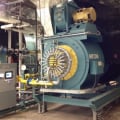Welcome! Here are the website rules, as well as some tips for using this forum.
Need to contact us? Visit https://heatinghelp.com/contact-us/.
Click here to Find a Contractor in your area.
If our community has helped you, please consider making a contribution to support this website. Thanks!
2-pipe non-trap radiator question
Options
steam2pipe
Member Posts: 59
The other day, the plumber told me that in our condo we have 1-pipe and 2-pipe radiators serving 10 units with steam heat. He said that 2-pipe non-trap radiators were on a ‘circuit’ and if one valve was turned off on one of these radiators, it would affect the whole heating system. He also said that 1-pipe radiator valves were independent of the system and could go on and off. Another owner was then told by a different plumber that valves on these 2-pipe non-trap radiators could go off or on and it would not affect the system because these 2-pipe not trap radiators were technically all 1-pipe radiators in the end. Which is correct? Also, if the 2-pipe non-trap radiator is considered 1-pipe, how does this work?
0
Comments
-
-
2 pipe non-trap? I do wonder what exactly that means. There are such beasts, yes -- but in several flavours. Could you possibly post pictures of the inlet and outlet fittings of them? Also, do they have vents on them, like the one pipe ones do. Do you have any way of finding out what the outlet pipes connect to, and where?
As to valves. No, they aren't on a circuit. The different plumber is correct in that turning them off won't affect the rest of the system much (it will a little, but that gets a bit technical at this point). One pipe radiators, however, should never be turned off with the inlet valve (they can be turned off by closing the vent). The reason being not that that will affect the system, but that it is very likely to cause water hammer in the radiator and other nuisances.Br. Jamie, osb
Building superintendent/caretaker, 7200 sq. ft. historic house museum with dependencies in New England1 -
I don't have pictures to share but there are valves on both sides of the 2-pipe radiators yet the plumber just turned one on the right. I believe they are supply and return valves. The 1-pipe radiators only had one valve. As far as getting photos, that will be hard at this time (no camera) but the outlet pipes go down under the floor and we were told that each radiator has its own connection to the boiler so the pipes must be in the wall.0
-
PS The radiators do have air vents on them. We all share one boiler for 10 units (plus 2 get hot water return due to bsmt location) so I suggested lowering the pressure. It is at 2psi right now but the plumber said it had to stay at that level. If all the pipes to the radiators go directly to the boiler's main piping, why won't the steam go equally to all the units regardless of the floors they are on? The plumbers said the risers and piping from the boiler are correct.0
-
Generally, the radiators and boiler would have been sized when first installed, so that each of them would give the correct heat for the room in which it was located.
If you have some rooms which overheat, then there may be a problem with the main venting not being able to get the air out off the supply piping quickly enough.—NBC1 -
It could be a 2 pipe, air vent system.
Here's an article from the "system resource center".
https://heatinghelp.com/systems-help-center/two-pipe-air-vent-steam-heating/Bob Boan
You can choose to do what you want, but you cannot choose the consequences.1 -
That’s refered to as a two pipe air vent system.
My suggestion - buy two of Dan Holohan’s books here from the store. The Lost Art of Steam Heating Revisited. And Greening Steam. In The Lost Art you can read about two pipe air vent systems and see how they are typically laid out. And in Greening Steam dan goes in-depth on making sure you have the correct venting etc.
There should be no issues with turning off one of the two pipe radiators. The only impact I could see it having is if the system isn’t vented properly those air vents on the radiators might be the only vents in the system or on the risers. It may slow down how quickly steam gets to the other radiators in that riser by reducing the amount of venting capacity in that riser. Ideally each main and each riser should be vented individually with the radiator vent only being used to vent the air in the radiator and it’s run-out piping.
https://heatinghelp.com/systems-help-center/two-pipe-air-vent-steam-heating/
https://heatinghelp.com/blog/dealing-with-an-old-two-pipe-air-vent-steam-system/Never stop learning.2 -
Thanks. I did buy the "Lost Art of Steam Heating Revisited" and have been reading the book. "Greening Steam" will be next on my list. Most of what I have read has helped me get this far in the discussion. Thanks for the links to these articles. I'm trying to learn as much as I can so I can help to explain things to the other owners affected by this same heating system.0
Categories
- All Categories
- 87.3K THE MAIN WALL
- 3.2K A-C, Heat Pumps & Refrigeration
- 61 Biomass
- 429 Carbon Monoxide Awareness
- 120 Chimneys & Flues
- 2.1K Domestic Hot Water
- 5.8K Gas Heating
- 114 Geothermal
- 166 Indoor-Air Quality
- 3.7K Oil Heating
- 77 Pipe Deterioration
- 1K Plumbing
- 6.5K Radiant Heating
- 395 Solar
- 15.7K Strictly Steam
- 3.4K Thermostats and Controls
- 56 Water Quality
- 51 Industry Classes
- 50 Job Opportunities
- 18 Recall Announcements



